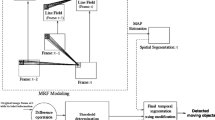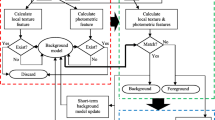Abstract
In this article, we propose a moving objects detection scheme using Gibbs–Markov random field(GMRF) and Hopfield-type neural network (HTNN) in expectation maximization (EM) framework for video sequences captured by static camera. In the considered technique, the background model is built by considering a running Gaussian average over few past frames. The change vector analysis (CVA) scheme is followed on the considered target frame and the constructed reference frame to generate a difference image. The moving objects in target frame are detected by segmenting the difference image into two classes: changed and unchanged, where the changed class represents moving object regions and the unchanged class the background regions. For segmentation, we have modeled the CVA generated difference image with GMRF and the segmentation problem is solved using the maximum a posteriori probability (MAP) estimation principle. The MAP estimator is found to be exponential in nature; and thus a modified HTNN is exploited for estimating the MAP. The parameters of the GMRF model are estimated using EM algorithm. Experiments are carried out on three video sequences. Results of the proposed change detection scheme are compared with those of the codebook-based background subtraction and GMRF model with graph-cut schemes. It is found that the proposed technique provides better results.










Similar content being viewed by others
References
Besag J (1986) On the statistical analysis of dirty pictures. J R Stat Soc Ser B (Methodol) 48(3):259–302
Bovic AL (2000) Image and video processing. Academic Press, New York
Brekke E, Hallingstad O, Glattetre J (2012) Improved target tracking in the presence of wakes. IEEE Trans Aerosp Electron Syst 48(2):1005–1017
Brutzer S, Hoferlin B, Heidemann G (2011) Evaluation of background subtraction techniques for video surveillance. In: Proceedings of IEEE conference on computer vision and pattern recognition (CVPR), pp 1937–1944
Durucan E, Ebrahimi T (2001) Change detection and background extraction by linear algebra. Proc IEEE (Spec Issue Adv Video Surveill) 89(10):1368–1381
Elgammal A, Duraiswami R, Harwood D, Anddavis L (2002) Background and foreground modeling using nonparametric kernel density estimation for visual surveillance. Proc IEEE 90(7):1151–1163
Ghosh A, Pal NR, Pal SK (1991) Image segmentation using a neural network. Biol Cybern 66:151–158
Ghosh A, Subudhi BN, Ghosh S (2012) Object detection from videos captured by moving camera by fuzzy edge incorporated Markov random field and local histogram matching. IEEE Trans Circuits Syst Video Technol 22(8):1127–1135
Ghosh S, Bruzzone L, Patra S, Bovolo F, Ghosh A (2007) A context-sensitive technique for unsupervised change detection based on Hopfield-type neural networks. IEEE Trans Geosci Remote Sens 45(3):778–789
Hopfield JJ (1984) Neurons with graded response have collective computational properties like those of two state neurons. Proc Natl Acad Sci USA 81:3088–3092
Kim K, Chalidabhongse TH, Harwood D, Davis L (2005) Real-time foreground-background segmentation using codebook model. Real-Time Imaging 11(3):167–256
Lehmann EL, Romano JP (1997) Testing statistical hypotheses. Springer, New York
Li SZ (2001) Markov random field modeling in image analysis. Springer, Japan
Liu Z, Sarkar S (2005) Effect of silhouette quality on hard problems in gait recognition. IEEE Trans Syst Man Cybern Part B Cybern 35(2):170–183
Manjunath BS, Simchony T, Chellappa R (1990) Stochastic and deterministic networks for texture segmentation. IEEE Trans Acoust Speech Signal Process 38(6):1039–1049
Monnet A, Mittal A, Paragios N, Ramesh V (2003) Background modeling and subtraction of dynamic scenes. In: Proceedings of IEEE international conference on computer vision (ICCV), pp 1305–1312
Pal S, Dutta Majumder D (1986) Fuzzy mathematical approach to pattern recognition. Wiley, New York
Piccardi M, Jan T (2004) Mean-shift background image modelling. In: Proceedings of international conference on image processing, vol 5, pp 3399–3402
Poppe C, Martens G, De Bruyne S, Lambert P, Van de Walle R (2008) Robust spatio-temporal multimodal background subtraction for video surveillance. Opt Eng 47(10):107–203
Portela-Sotelo MA, Desseree É, Moreau JM, Shariat B, Beuve M (2012) 3-D model-based multiple-object video tracking for treatment room supervision. IEEE Trans Biomed Eng 59(2):562–570
Potts RB (1952) Some generalized order-disorder transformations. Proc Camb Philos Soc 48:106–109
Radke RJ, Al-Kofahi Andra S (2005) Image change detection algorithms: a systematic survey. IEEE Trans Image Process 14(3):294–307
Rajgopalan AN, Chellapa R (2001) Higher order statistic based detection of people/vehicle in images. Proc Indian Natl Sci Acad 67A:157–166
Rojas R (1996) Neural networks. Springer, Berlin
Shanmugam KS, Breipohl AM (1988) Random signals detection, estimation and data analysis. Wiley, New York
Shapiro A, Nemirovski A (2005) On complexity of stochastic programming problems. In: Jeyakumar V, Rubinov A (eds) Continuous optimization, applied optimization, vol 99. Springer, US, pp 111–146
Singh A (1989) Review article digital change detection techniques using remotely-sensed data. Int J Remote Sens 10(6):989–1003
Stauffer C, Grimson WEL (1999) Adaptive background mixture models for real-time tracking. In: Proceedings of international conference on computer vision and pattern recognition, pp 2246–2252
Stauffer C, Grimson WEL (2000) Learning patterns of activity using real time tracking. IEEE Trans Pattern Anal Mach Intell 22(8):747–767
Subudhi BN, Ghosh S, Ghosh A (2013) Change detection for moving object segmentation with robust background construction under Wronskian framework. Mach Vis Appl 24(4):795–809
Subudhi BN, Nanda PK, Ghosh A (2011) A change information based fast algorithm for video object detection and tracking. IEEE Trans Circuits Syst Video Technol 21(7):993–1004
Szeliski R, Zabih R, Scharstein D, Veksler O, Kolmogorov V, Agarwala A, Tappen M, Rother C (2008) A comparative study of energy minimization methods for Markov random fields with smoothness-based priors. IEEE Trans Pattern Anal Mach Intell 30(6):1068–1080
Tekalp AM (1995) Digital video processing. Prentice Hall, New Jersey
Wren C, Azarbayejani A, Darrell T, Pentland A (1997) Pfinder: real-time tracking of the human body. IEEE Trans Pattern Anal Mach Intell 19(7):780–785
Author information
Authors and Affiliations
Corresponding author
Additional information
Communicated by V. Loia.
Rights and permissions
About this article
Cite this article
Subudhi, B.N., Ghosh, S. & Ghosh, A. Application of Gibbs–Markov random field and Hopfield-type neural networks for detecting moving objects from video sequences captured by static camera. Soft Comput 19, 2769–2781 (2015). https://doi.org/10.1007/s00500-014-1440-4
Published:
Issue Date:
DOI: https://doi.org/10.1007/s00500-014-1440-4




